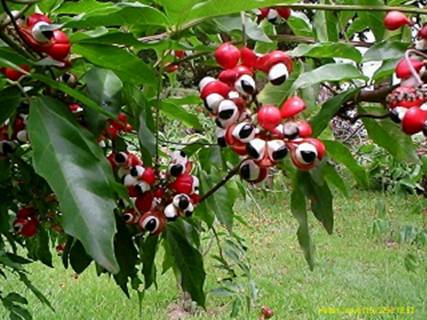PAULLINIA RUBIGINOSA
POPULAR NAMES: GUARANAÍ, GUARANÁ DE CIPÓ DA MATA ATLANTICA, INGA DE COBRA, UARANI
SAPINDACEAE

INDIGENOUS NAME: Guaranaí comes from the Tupi-Guaraní language and means "fruit that sees or observes," as in fact they show to be.
Origin: Native forest galleries along the rivers of the Atlantic Forest and easily found on the banks of rivers: Paranapanema, Piracicaba, Itapetininga, Tietê, Jaú, Guareí and many others, located in the southeastern state of São Paulo, appearing in Rio de Janeiro, Paraná, Santa Catarina, can also be found in Bolivia, Argentina and Paraguay.
Characteristics:
It is a woody climber with
flexible
branches of the length of
Planted in the site of Frutas Raras: October 2002, bear fruit for the first time in February 2004.
Tips for
cultivation: The
fast growing climbing plant
that resists low temperatures (to -4°C (25°F)), and grows from sea level to
altitudes above
Propagation: The
seeds are recalcitantes (lose their germinative power if dried).
Germination occurs in
Planting:
Can be planted in full
sun and shade in forests with large trees well spaced.
Space between plants 4 x 4 m (13 x 13 feet).
The espalier should have 6 pillars, in the distances of
Cultivating: Make
only the formation of crown pruning and remove the shoots that were grown
from the base of the stem, manage the branches by a tutor until they fix the
espalier.
Fertilize with organic compost, can be
Uses: Fruits are triangular red capsules that open, exposing a sweet and edible white aril. Seeds which are black and slightly smaller than the Amazon Guarana (Paullinia cupana) have the same uses. To drink Guarana, follow the steps: the bunch of fruit is harvested when the majority of the capsules are opened, leave them stacked to the fermentation of aril facilitates the separation of the seeds is done by hand and washed on a sieve. Then the seeds are roasted in the furnace plate for removal of skin or bark. The almonds are smashed in a pestle with a little water until it has the consistency of a paste, then, this folder is shaped and carried into an dryer oven. Hence the rods are dried grated or ground, left as dust and is ready to be processed in the delicious energy drink of guarana.
Flowering in the site of Frutas Raras: November to December.
Fruiting in the site of Frutas Raras: End of January until early March.
BUY THE BOOK “COLECIONANDO FRUTAS”
Back to the seedlist (English) or back to Sapindaceae (Portuguese)